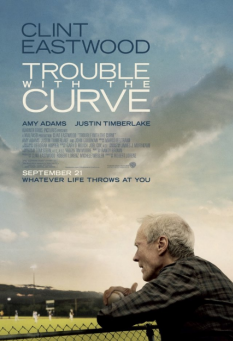Print Edition: September 26, 2012
 The only forward thinking idea in Trouble with the Curve is the depiction of the Boston Red Sox as strong contenders for the number one selection in the first year player draft. And that, every thing about the movie screams, is precisely the point. Setting aside all of the baseball monologue, Clint Eastwood’s father character Gus and Amy Adams’ daughter character Mickey are brought together to talk about the past, remember and regret things from the past, and ultimately think long and hard about how their pasts apparently excuse what they are in the present. In spite of its set-up as a contrarian story, Trouble with the Curve is a load of unversed nonsense, an unconflicted view of baseball and life that agrees with itself.
The only forward thinking idea in Trouble with the Curve is the depiction of the Boston Red Sox as strong contenders for the number one selection in the first year player draft. And that, every thing about the movie screams, is precisely the point. Setting aside all of the baseball monologue, Clint Eastwood’s father character Gus and Amy Adams’ daughter character Mickey are brought together to talk about the past, remember and regret things from the past, and ultimately think long and hard about how their pasts apparently excuse what they are in the present. In spite of its set-up as a contrarian story, Trouble with the Curve is a load of unversed nonsense, an unconflicted view of baseball and life that agrees with itself.
First-time director Robert Lorenz, though working with Clint Eastwood’s regular cinematographer Tom Stern and editor Joel Cox, does nothing to distinguish any of the person searching and watching. A movie calling for emotion that’s comprised of flat, rhythmless vacancies, Trouble with the Curve takes place in bars, motels, bleachers and boardrooms. This is the natural habitat of the made-for-television or television re-run movie, an approach pounded home by the appearance of Justin Timberlake, almost as lifeless as his minor league baseball player-aspiring writer in the similarly themed The Open Road. Like that atrocity, Curve is a screenwriter’s concoction, one lacking in focus or anything vivid. There’s the father-daughter connection, with Clint Eastwood now an emulation of a parody of an image of himself, to hang a few memories on, but nothing approaching a follow-through after the establishing shots. Trouble with the Curve has no central character, only generalities, and if ever another being finds itself in the frame, it is only as a reflection of problems that have already been expounded upon.
Maybe this distance is to provide room for the baseball argument. But this too is a sham of a picture. Randy Brown’s script takes the understandable view of disliking how technology is making people expendable in the minds of some and a universal appeal to the love of watching the sport of baseball, and contorts them into a one-sided, simple-minded grotesque diatribe. Scouts watch the game, know the game, and law school grads read out numbers with no eye for the details, no love of baseball. This is so cartoonish that it hardly deserves to be taken seriously, but it is a real divide, and Trouble with the Curve seizes the opportunity of being the self-flattering emblem of a staunch position. There are problems everywhere in the way Curve deals with this. The so-called numbers crew stake their claim on small sample sizes and batting average, making one anticipate Trouble with Pitch Location, in which win-loss records and ERA are trotted out by the youngish cocksure wannabe general managers. The scope is limited, oppressively unrepresentative, here. Statistics can provide analysis, and are not always a symbol of idiotic anti-humanism, and surely scouts can provide more than a pitch sound effects description. It’s a function of a lazy argument to distort facts to the point of laughability, and Trouble with the Curve sets to this with no reservations. Sabremetricians watch baseball games, and scouting is informed in part by statistics. Trouble with the Curve hopes its audience is ignorant to this, isn’t thinking even the most rudimentary things about what it is to watch something.
The actual depiction of the sport isn’t very different in approach. There’s an emphasis on sound, which boils down to hating the alien aluminum ping of a bat and loving the muffled leather smack of a caught ball. The sport is slashed visually, cuts to at-bats that would make someone who only knows the sport through SportsCentre think something is off, every swing a violent misrepresentation of what draws people to baseball. At one point Amy Adams asserts that “it’s just a game,” which provides the necessary motivation for the movie to get on its way to ending. But there are some commonalities between baseball, the cinema, and life. All find their excitement and unforgettable qualities in the way variation arises out of routine. Scouts observe and learn how to anticipate, statistics document and serve as a basis for analysis, and people, filmmakers and otherwise, do all of the above. Trouble with the Curve, divisive and blind, doesn’t even begin to comprehend all of this.


